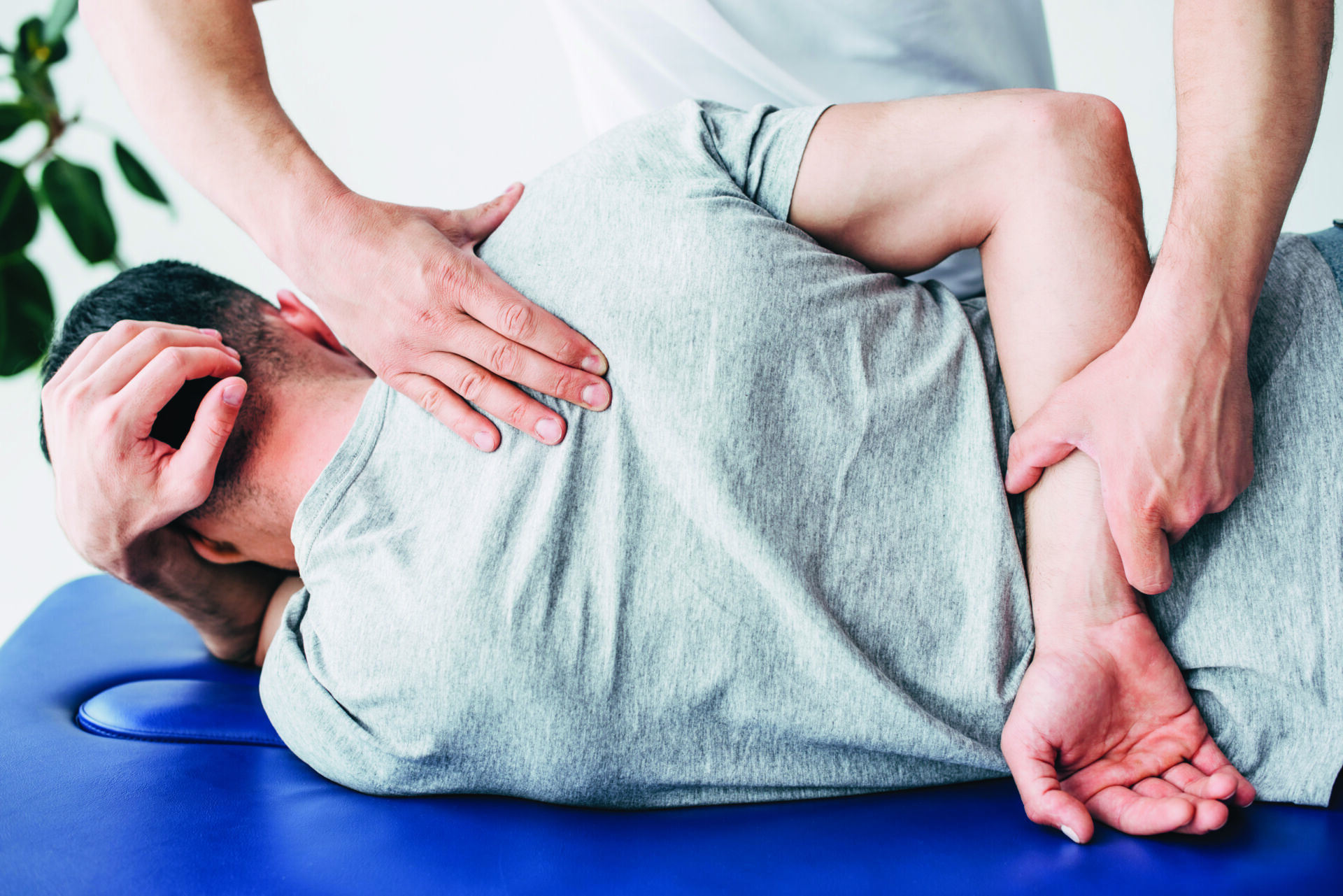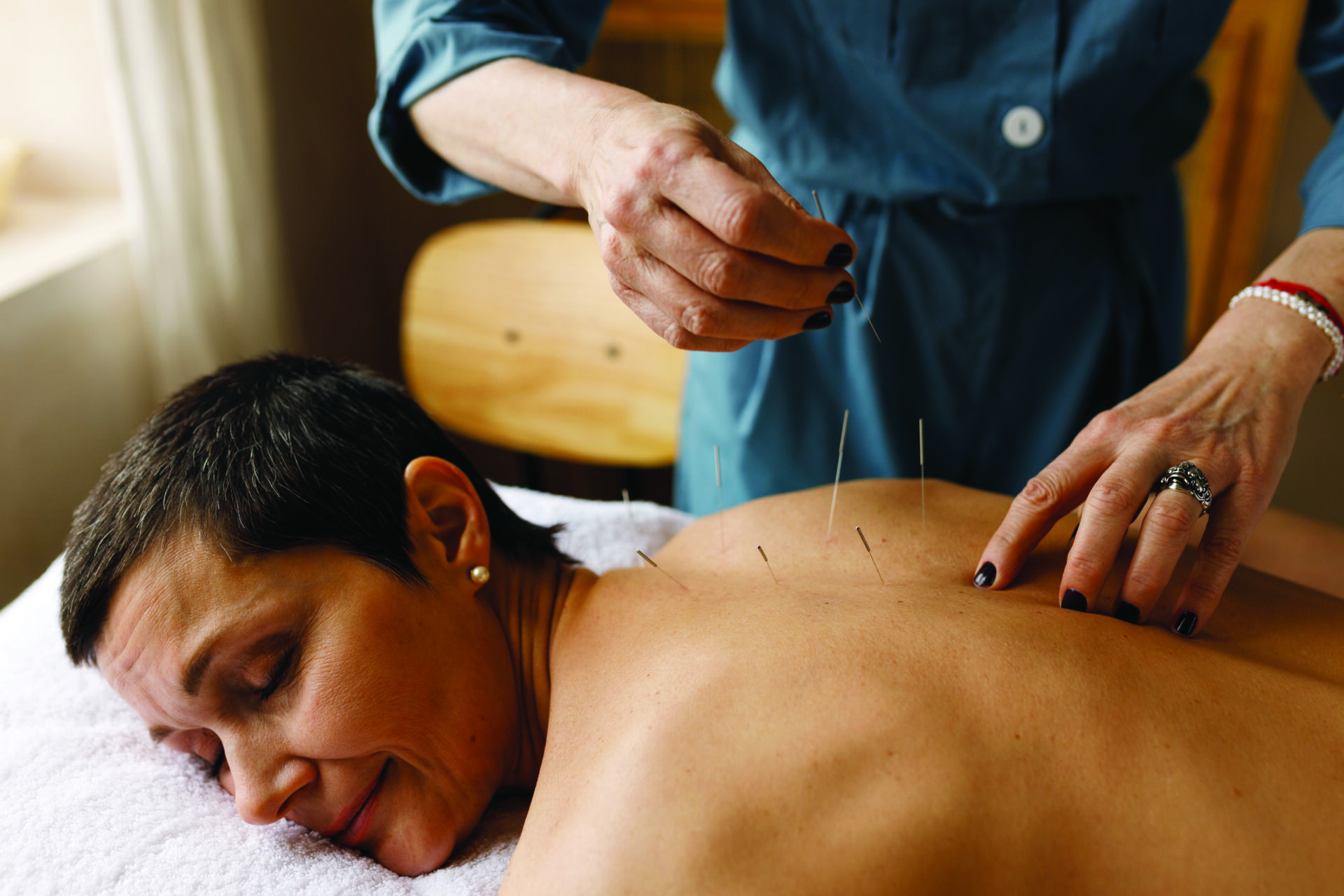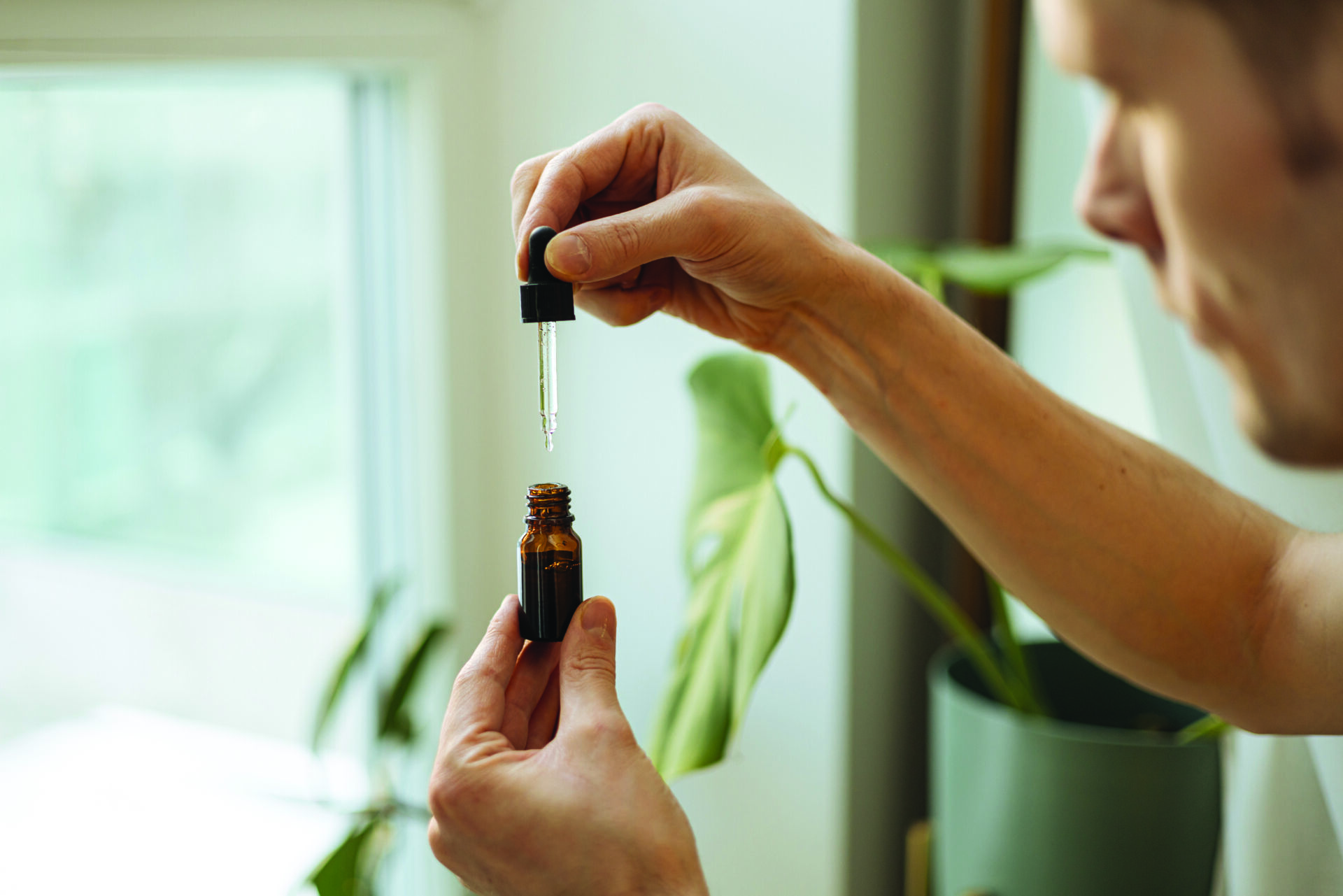Read The
Current Issue
Holistic Healing
Complementary therapies offer diverse paths to pain relief—without pills.
// By Bevin Wallace
My orthopedic doc said I was wasting my money and time when, after almost two years of MRIs, steroids, injections, and PT, I told him I was going to see a chiropractor for my ongoing hip pain. “There is no evidence that chiropractic works,” he said, sighing. To which I replied, “At this point, it can’t hurt.” After about six weeks of regular visits to the chiropractor, who I’d heard was a “miracle worker,” my pain was gone. I didn’t even need the daily dose of Advil I’d taken for ages. It does seem like a miracle.
Chiropractic is just one form of complementary pain management. The long list of these therapies, many of which have been used throughout history, includes acupuncture, yoga, hypnosis, biofeedback, aromatherapy, herbal remedies, massage, grounding, diets, supplements, CBD, guided imagery and visualization, therapeutic touch, reiki, tai chi, relaxation, meditation, magnets, and copper. Oh, and snake oil—which is how many in the medical establishment (like my doctor) tend to characterize them.
More and more people are looking for integrative methods that can be beneficial.”
Although some if not all of these therapies can be effective and the body of research into them is growing rapidly, most still have not been scientifically studied to the extent that many physicians feel comfortable exclusively prescribing them. Yet they are gaining in popularity and acceptance, especially among frustrated patients who aren’t finding relief from traditional Western medicine. “More and more people are looking for integrative methods that can be beneficial,” says Kevin Meehan, a licensed acupuncturist and owner of Teton Valley Health Clinic, an integrative health clinic in downtown Jackson. “The resistance by modern medical doctors is an impediment to people getting better. We need to look at injuries and health conditions from all perspectives.”
A large variety of these perspectives are available in Jackson Hole. “Jackson is very holistic,” says Francine Padrón Bartlett, founder of Medicine Wheel Wellness in Jackson. “There are a ton of wellness practitioners doing a lot of different and interesting things here.” In her practice, Padrón Bartlett, who has a doctorate in physical therapy, emphasizes the four aspects of well-being—physical, mental, emotional, and spiritual health—to come up with a care plan for her clients, who, not surprisingly, are mostly “active, sporty people,” she says. Medicine Wheel Wellness seeks to integrate modern medicine with ancient wisdom and principles of nature, and the facility offers an array of services, including guided imagery, deep energy healing, earthing, massage therapy, PT, fitness, yoga, and Chinese medicine. Padrón Bartlett stresses that these therapies should be seen as integrative as opposed to alternative and agrees with Meehan that complementary healing practices can enhance the outcomes of mainstream medicine.
Jackson is very holistic. There are a ton of wellness practitioners doing a lot of different and
interesting things here.”— Francine Padrón Bartlett, physical therapist
“Fifty percent of people in our country do it on their own. They go to a chiropractor, they take herbs, they do mind-body therapies, they do magnets,” says Jed Shay, M.D., medical director for Pain Care Centers of Wyoming. While Shay does advocate “evidence-based” medicine, he believes physicians should have an open mind about considering other options. “We do not rule out alternative medicine at all,” he says. “When a patient has exhausted all evidence-based medicine and has come to us and we have treated them based on traditional medicine and they don’t get the answer they’re looking for, then I would consider complementary medicine.”
Over 70 million Americans suffer from chronic pain, according to a 2020 study published in the Journal of Alternative and Complementary Medicine, so more research is needed into these potentially life-improving techniques. Here’s an overview of some of the most common complementary pain-management therapies and what’s currently known about their effectiveness.

Mind-Body Techniques
Best for: chronic pain, fibromyalgia, cancer pain
Mind-body approaches—including progressive muscle relaxation, meditation, yoga, deep breathing, laughter, forest bathing, mindfulness-based stress reduction, hypnosis, guided imagery, biofeedback, tai chi, and cognitive behavioral therapy—aim to change our awareness of pain and how we deal with it. These techniques won’t erase pain, however, according to Heidi Godman, executive editor of the Harvard Health Letter, “They can help change the perception of pain intensity through distraction, relaxation, and reframing our thoughts.”
There’s a lot of overlap among these approaches; for example, progressive muscle relaxation is often part of guided meditation, and deep breathing is used in yoga practice. A therapist trained in CBT can help you learn to manage your pain mentally using visualization techniques, and MBSR uses a form of meditation to help you accept experiences, including pain, in the present moment. A 2019 study published in the journal Evidence-Based Mental Health found MBSR to be as effective as CBT in reducing pain and depression, as well as improving physical function as compared with usual forms of health care.
Many people use some form of mind-body medicine, even if they don’t realize they’re doing it. “Do you know what’s the most common form of alternative medicine people use? It’s prayer,” says Shay.
Spending time in nature also falls into the category of mind-body healing, and Medicine Wheel’s Bartlett thinks it’s, ironically, what a lot of Jacksonites need. “In the Jackson community, people get outside to conquer,” she says. “We try to teach them to connect with nature, to be heartfelt. There is healing in that.”

Chiropractic and Massage
Best for: lower back and neck pain, reduced need for opioids
According to the American Chiropractic Association, over 35 million Americans see a chiropractor at least once a year, and a growing body of research shows it to be generally safe and effective. The results of a 2018 clinical trial published in the JAMA Network open-access medical journal found that “chiropractic care combined with usual medical care for low back pain provides greater pain relief and a greater reduction in disability than medical care alone.” Studies have also shown that it can decrease long-term opioid use: a 2019 study published in Pain Medicine showed that chiropractic users had 64 percent lower odds of receiving an opioid prescription than non-users. Still, Shay points out that more double-blind randomized studies are needed, and he cautions against seeing a chiropractor before getting a diagnosis from a physician. “You shouldn’t consider alternative medicine exclusively because there is a chance of misdiagnosis. Your back pain could be caused by a more severe condition,” he says. “I tell my patients, go if it helps you, and for some it does, but that’s after you’ve had all the diagnostics and therapeutics used in Western medicine.”
Shay says the pain-relieving mechanism in massage is that it increases blood flow to the affected area, which can remove the “nasty byproducts of metabolism;” to the extent that those were causing pain, the pain is reduced. “It also reduces stress, and that is therapeutic,” he says.

Acupuncture
Best for: headaches, back and neck pain, arthritis, tennis elbow
In traditional Chinese medicine, acupuncture is believed to balance the flow of energy (qi, pronounced “chi”) in the body. By inserting very thin needles into specific points along the qi’s pathways, practitioners aim to rebalance your energy flow, alleviating symptoms such as pain and inflammation. Western practitioners believe acupuncture points also happen to be places where nerves, muscles, and tendons are stimulated, and that stimulation can boost your body’s natural ability to reduce pain. There have been many studies that demonstrate acupuncture’s effectiveness—including a University of Pennsylvania study of women with joint pain related to breast cancer medication that found a 43 percent reduction in pain severity among the group that received acupuncture compared to the women who just thought they were getting it and the control group. But none have been able to fully explain how acupuncture works within the framework of Western medicine, so acupuncture remains a source of skepticism. However, acupuncture carries very little risk if you see a licensed acupuncturist. After 33 years in Jackson treating adventure-induced injuries in climbers, skiers, and lacrosse players, Meehan says there are plenty of acupuncture nay-sayers who come into his clinic because of its reputation. “But then they become convinced because it works,” he says.

Dietary Approaches and Supplements
Best for: abdominal pain, migraines, neuropathy
In summarizing a 2020 survey of studies published on the National Institute of Health’s PubMed site, the authors wrote: “Besides classical and alternative methods of treatment described in literature, it was observed that different diets are also a valid solution, due to many components with antioxidant and anti-inflammatory qualities capable to influence chronic pain and to improve the quality of life.” The studies cited benefits for certain conditions from restricting calories as well as gluten-free and lactose-free diets, as well as omega-3, antioxidants, and some supplements, including vitamin E and D3. Meehan also believes in the power of nutrition and supplements, and he says he cured his own Type II diabetes by putting his education in biochemistry and integrative health to use and changing his diet. He now holds patents on several supplements that use the biochemical building blocks of the human body to deliver results, including joint support and weight loss.
Much more research is needed to better understand the complex interactions in human nutrition, but it’s fairly well established that a healthy diet can help reduce pain. “One of the conditions we see in patients with chronic pain is obesity,” Shay says. “That extra weight, directly and indirectly, causes increased pain; it directly increases the stress on your body and spine.” So, assuming you’ve been cleared by a doctor, stir that blueberry powder into your smoothie.

CBD
Best for: muscle and joint pain and inflammation, headaches
Cannabidiol (CBD) is one of many compounds in Cannabis sativa L. It has no psychoactive effects (it doesn’t make you high), and it is gaining popularity for its purported therapeutic benefits, ranging from better sleep to reduced epileptic seizures and pain relief. A 2020 study review published in Frontiers in Pharmacology showed CBD to be “effective for intractable pain” and that it “increases the bioavailability of analgesics.” However, the authors stressed that more studies are needed, that the use of CBD is context-specific, and that “it should not be used indiscriminately.” They also warned about possible public health hazards from “a tsunami” of unregulated CBD products that could contain toxic compounds and concerns about the effects of CBD on fetal development. JH





